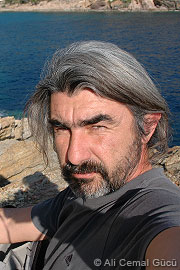


 | ||
 |  | |
Vol. 12 (1): June 2009 | ||
Monk seal: metaphor for the Mediterranean ecosystemby Ali Cemal Gücü
The other reason was, I was more for the dolphins. In my child’s eye, the sea was a marvellous kingdom, as described in the tales of my grandmother. Each inhabitant was given a role. The dolphins were the swift cavalries of the kingdom, and the seals were the watchdogs of the king. Who goes for a sluggish watchdog when the whole kingdom was under the flippers of a playful cavalry? The first thing I remember about them was a story told to my grandfather during his childhood. This was about a “womanizer” seal. During the time of the Ottoman Empire, ladies were accustomed to swimming in private, guarded enclosures on the coast called “deniz hamamı [sea bath]”, which were strictly forbidden to men. In the story, one day someone with a bushy moustache sneaks into a sea bath and starts swimming among the ladies. Discovering him, the women run out, yelling in panic, since being seen half-naked by a stranger was considered a dreadful sin. Then the guards run in to catch and punish the “womanizer” – only to discover that the one with a bushy moustache is not a man at all, but a monk seal. The adjective my grandfather used for the seal was “rascal”. This was the term people used to give to the seals; the rascals of the sea. Even for the fishermen they were playful rascals, sharing their destiny in the sea. Later, I encountered monk seals in the books of Turkish novelist, Fisherman of Halicarnassus (Cevat Şakir Karaağaçlı), that I am great fan of. In his books, they are respectful inhabitants of the sea; sometimes rescuing fisherman in danger, sometimes disguised as mermaids, marrying the fisherman who falls in love with them. During my education at university, an ecosystem was described as an integral entity in which each element is closely linked to the other. Within this context, each species is given an equal importance, unless they happened to be a keystone species, which has a disproportionate effect on its environment relative to its abundance. The Mediterranean monk seals were few in number; however, they were not, in any sense, keystone species in the Mediterranean ecosystem. Therefore, for a freshman marine ecologist, efforts to protect one single species seemed a waste of time. How could activities like subsidizing fishermen for their damaged nets save the species? How could the protection of one or two caves, essentially a single spot within a seal’s entire home range, help protect the seal, when the entire ecosystem was in danger? How could such actions help them raise their pups, when an uncontrolled fishery was depleting their main food source? Or how, as an apex predator, would they survive the toxic blooms triggered by the ever-increasing eutrophication problem on the coast. In short, at university the monk seal and monk seal conservation were not for me at all. But then in 1993-94 I happened to meet people from a WWF-International led monk seal conservation project in Foça, who asked me to undertake a survey on the status of the seals on the Mersin coast. Although I had no confidence in single species conservation, working on the monk seal sounded like fun, involving tough and exciting work at sea. Hence, I accepted the offer, and began the survey in ‘94. The first three months were a challenge. With my team, we worked hard to discover the caves where the seals hide, but then began realizing how bad the situation was along even the most intact coasts. The ‘rascals’ of the elders had turned into pests to be eradicated for the new generation. The seals no longer figured in village folktales. For children, a seal was a marine mammal living in the polar seas, brutally killed by hunters. They did not even know that a seal species existed in the Mediterranean. These first three months taught me that ecology is not only the equations that I was taught at the university, and that what is happening out in nature is far beyond the ecosystem models I designed. During the following years, I attempted to interpret the meaning of “indicator species” with the monk seal, and to understand how they indicate the health of the ecosystem. The problems facing the seals were essentially the same problems threatening the entire Mediterranean ecosystem. With them, I have clearly understood the concept of “umbrella species”. I have learnt how the name “monk seal” signifies conservation of the entire ecosystem. I was very much surprised when the Turkish Ministry of Agriculture and Rural Affairs accepted my proposal to establish a ban on trawling at a site inhabited by the seals. Without mentioning the monk seal, the same proposal had been refused for 11 years because the ministry was afraid of being put under pressure by the fishermen. Under the monk seal’s umbrella, the concern was not for the industrial fishermen anymore, but international agreements, conventions, understandings… As a consequence of all this, the species I once ignored has become one of the most important things in my life. On the one hand, I am hopeful for their future, because I have seen how they reacted positively to conservation measures enforced along the Cilician coats; how they returned to the caves they had once abandoned; how the growing colony is beginning to spill over into neighbouring regions. But on the other hand, I have learnt that it is human greed that the monk seal ultimately has to withstand – a force that ambushes conservation efforts whenever there is a conflict between protection and exploitation.
Ali Cemal Gücü is a professor of marine biology at Middle East Technical University, Institute of Marine Sciences, Turkey. |
 Copyright © 2009 Ali Cemal Gücü, The Monachus Guardian. All Rights Reserved |